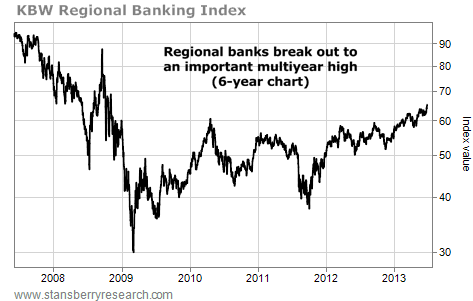| Home | About Us | Resources | Archive | Free Reports | Market Window |
The Best Dividend Stocks Nobody Is BuyingBy
Friday, June 28, 2013
The press is beginning to catch on to "the best dividend payments you've never heard of"...
Back in February, I urged readers to study a little-known area of the market. This area is generally ignored by large investors. But it's an extraordinary place to shop for great income investments.
These income-producing businesses have top brand-name products... They generate steady free cash flow... They have major competitive advantages over their competitors... And they pay out big dividends.
I'm talking about the best small-cap dividend-paying companies in America.
One of my favorite stocks here, Diebold (NYSE: DBD), was just profiled in the financial weekly Barron's.
Diebold is the world's No. 1 supplier of automatic teller machines (ATMs). It's also a leading supplier of security products, like bank vaults and safes. It's a 150-year-old company. And it has increased its dividend payment every year for 59 years, which is the longest streak of any company in North America.
Even the 2008 financial crisis didn't stop Diebold from raising its dividend payouts a few cents each quarter. In 2007, Diebold paid $0.94 per share in dividends. For 2012, shareholders received a total of $1.14 per share. That's a 3.6% yield at today's price.
It's important to focus on elite dividend-paying companies like Diebold because they allow you to safely compound your money. Any sophisticated investor – including Peter Lynch and Warren Buffett – will tell you that "compounding" is one of the most important investment concepts to understand. Albert Einstein called it "the most powerful force in the universe."
Compounding is reinvesting the money you make from an initial investment to make even more money. In short, you earn money on the money you earn... If you do this over a long period, with an asset that pays increasing rates of income, you can earn staggering profits from your initial investment.
Most people who want to compound their returns over decades will look to buy well-known staple stocks, like Coke or McDonald's. The trouble with many top dividend-payers like these is that you often have to wait years to pick them up at bargain prices. Since everyone is familiar with these names, everyone wants to buy them.
But I'd guess not one investor in 100 has heard of Diebold and its amazing dividend streak. And it has a lot of the same positive attributes that giant dividend-payers like Coke and McDonald's have. It just happens to be much, much smaller than these giants... With a $2 billion market cap, it's less than 2% the size of Coke.
Like other top small-cap dividend-payers, Diebold provides brand-name products and services you might use every month. But its small size makes it fly under the radar of most investors. Big pension funds, mutual funds, and hedge funds are often too big to buy this kind of stock.
I've been urging readers of my Small Stock Specialist newsletter to buy Diebold and other top small-cap dividend payers for a while. Many still trade for great prices... and offer great yields.
But I'm seeing the press mention these stocks more often. If you're interested in this kind of income, make sure to buy soon.
Good investing,
Frank Curzio
Further Reading:
"The first step to a rich retirement is to buy dividend-paying stocks," Dan Ferris writes. But the most important step is reinvesting your dividends. "Reinvesting your dividends is the only easy money in the stock market. If you're an income-focused investor, following this strategy will make the difference between a good investment... and decades of comfortable retirement living." Learn more here.
Dan says many online brokers "will – automatically and for free – reinvest the dividends you receive in the stocks that pay those dividends." To take advantage of it, all you have to do is place a single phone call. Get all the details here.
Market NotesA BIG NEW BREAKOUT FOR REGIONAL BANKS After years of digesting bad loans and bad assets, bank stocks are on the rise. The KBW Regional Banking Index provides evidence here...
Banks partied hard during the 2003–2007 bull market in real estate, stocks, and commodities. Then, they suffered through one of the worst financial crises in U.S. history. Many bank stocks fell 70%... 80%... even 90%. Today's chart shows how the "hangover" has lasted years.
Our chart shows the price action in the KBW Regional Banking Index. This is a widely followed gauge of regional banking firms. These firms aren't the giant "too big to fail" banks like Bank of America and Citigroup. They tend to practice a more boring kind of banking, rather than trade trillions of dollars' worth of financial derivatives. They benefit when their local regions enjoy better economic times and rising asset values.
As you can see, this index crashed in 2008/2009. It spent the next four years "digesting" all of the bad loans acquired during the boom. But note the right side of the chart. This index just "broke out" of this giant sideways pattern... and sits at a multiyear high. For now, the market believes better times are here.
 |
In The Daily Crux
Recent Articles
|


